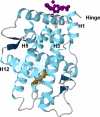Small molecule inhibitors as probes for estrogen and androgen receptor action
- PMID: 21149443
- PMCID: PMC3039394
- DOI: 10.1074/jbc.R110.203026
Small molecule inhibitors as probes for estrogen and androgen receptor action
Abstract
Because activated estrogen (ER) and androgen (AR) receptors stimulate cell proliferation in breast and prostate cancer, inhibiting their actions represents a major therapeutic goal. Most efforts to modulate ER and AR activity have focused on inhibiting the synthesis of estrogens or androgens or on the identification of small molecules that act by competing with agonist hormones for binding in the ligand-binding pocket of the receptor. An alternative approach is to implement screens for small molecule inhibitors that target other sites in the pathway of steroid receptor action. Many of these second-site inhibitors directly target ER or AR; others have still unknown sites of action. Small molecule inhibitors that target second sites represent new leads with clinical potential; they serve as novel modulators of receptor action; and they can reveal new and as yet unidentified interactions and pathways that modulate ER and AR action.
Figures



References
-
- Attard G., Reid A. H., Yap T. A., Raynaud F., Dowsett M., Settatree S., Barrett M., Parker C., Martins V., Folkerd E., Clark J., Cooper C. S., Kaye S. B., Dearnaley D., Lee G., de Bono J. S. (2008) J. Clin. Oncol. 26, 4563–4571 - PubMed
-
- Chen C. D., Welsbie D. S., Tran C., Baek S. H., Chen R., Vessella R., Rosenfeld M. G., Sawyers C. L. (2004) Nat. Med. 10, 33–39 - PubMed
-
- Debes J. D., Tindall D. J. (2004) N. Engl. J. Med. 351, 1488–1490 - PubMed
Publication types
MeSH terms
Substances
Grants and funding
LinkOut - more resources
Full Text Sources
Other Literature Sources
Research Materials

